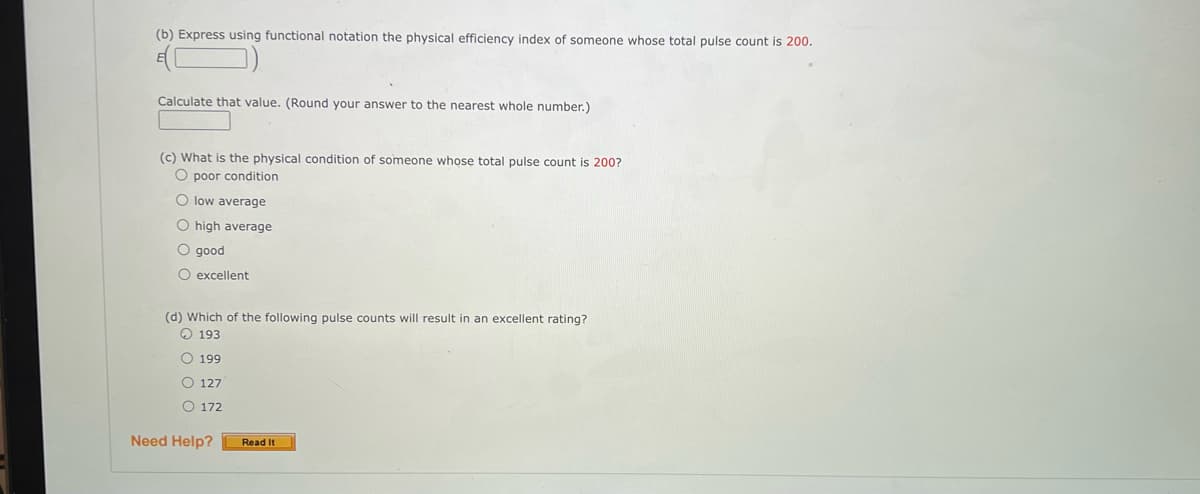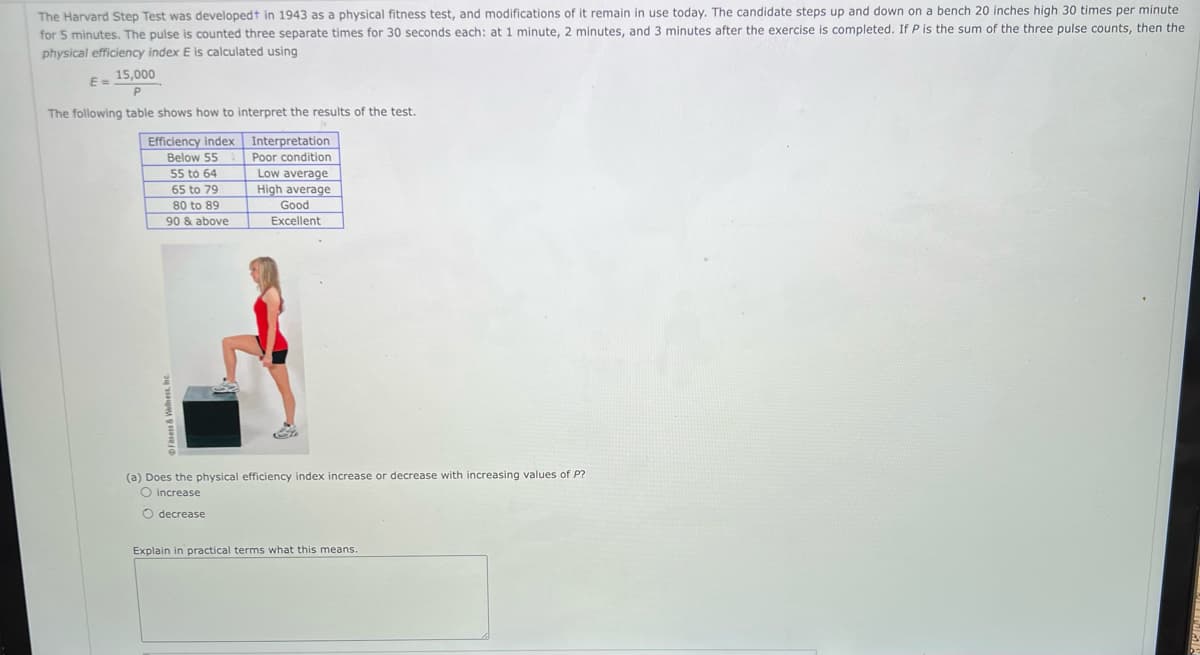The Harvard Step Test was developedt in 1943 as a physical fitness test, and modifications of it remain in use today. The candidate steps up and down on a bench 20 inches high 30 times per minute for 5 minutes. The pulse is counted three separate times for 30 seconds each: at 1 minute, 2 minutes, and 3 minutes after the exercise is completed. If P is the sum of the three pulse counts, then the physical efficiency index E is calculated using 15,000 E= The following table shows how to interpret the results of the test. Interpretation Efficiency index Below 55 Poor condition 55 to 64 Low average High average Good Excellent 65 to 79 80 to 89 90 & above (a) Does the physical efficiency index increase or decrease with increasing values of P? O increase O decrease Explain in practical terms what this means.
The Harvard Step Test was developedt in 1943 as a physical fitness test, and modifications of it remain in use today. The candidate steps up and down on a bench 20 inches high 30 times per minute for 5 minutes. The pulse is counted three separate times for 30 seconds each: at 1 minute, 2 minutes, and 3 minutes after the exercise is completed. If P is the sum of the three pulse counts, then the physical efficiency index E is calculated using 15,000 E= The following table shows how to interpret the results of the test. Interpretation Efficiency index Below 55 Poor condition 55 to 64 Low average High average Good Excellent 65 to 79 80 to 89 90 & above (a) Does the physical efficiency index increase or decrease with increasing values of P? O increase O decrease Explain in practical terms what this means.
Linear Algebra: A Modern Introduction
4th Edition
ISBN:9781285463247
Author:David Poole
Publisher:David Poole
Chapter4: Eigenvalues And Eigenvectors
Section4.6: Applications And The Perron-frobenius Theorem
Problem 25EQ
Related questions
Question

Transcribed Image Text:(b) Express using functional notation the physical efficiency index of someone whose total pulse count is 200.
Calculate that value. (Round your answer to the nearest whole number.)
(c) What is the physical condition of someone whose total pulse count is 200?
O poor condition
O low average
O high average
O good
O excellent
(d) Which of the following pulse counts will result in an excellent rating?
193
O 199
O 127
O 172
Need Help?
Read It

Transcribed Image Text:The Harvard Step Test was developedt in 1943 as a physical fitness test, and modifications of it remain in use today. The candidate steps up and down on a bench 20 inches high 30 times per minute
for 5 minutes. The pulse is counted three separate times for 30 seconds each: at 1 minute, 2 minutes, and 3 minutes after the exercise is completed. If P is the sum of the three pulse counts, then the
physical efficiency index E is calculated using
15,000
E=
The following table shows how to interpret the results of the test.
Interpretation
Efficiency index
Below 55
55 to 64
Poor condition
Low average
High average
Good
Excellent
65 to 79
80 to 89
90 & above
(a) Does the physical efficiency index increase or decrease with increasing values of P?
O increase
O decrease
Explain in practical terms what this means.
Expert Solution
This question has been solved!
Explore an expertly crafted, step-by-step solution for a thorough understanding of key concepts.
This is a popular solution!
Trending now
This is a popular solution!
Step by step
Solved in 2 steps with 2 images

Recommended textbooks for you

Linear Algebra: A Modern Introduction
Algebra
ISBN:
9781285463247
Author:
David Poole
Publisher:
Cengage Learning

Linear Algebra: A Modern Introduction
Algebra
ISBN:
9781285463247
Author:
David Poole
Publisher:
Cengage Learning